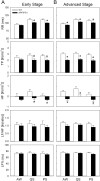Reduced slow-wave activity and autonomic dysfunction during sleep precede cognitive deficits in Alzheimer's disease transgenic mice
- PMID: 37433857
- PMCID: PMC10336117
- DOI: 10.1038/s41598-023-38214-6
Reduced slow-wave activity and autonomic dysfunction during sleep precede cognitive deficits in Alzheimer's disease transgenic mice
Abstract
Occurrence of amyloid-β (Aβ) aggregation in brain begins before the clinical onset of Alzheimer's disease (AD), as preclinical AD. Studies have reported that sleep problems and autonomic dysfunction associate closely with AD. However, whether they, especially the interaction between sleep and autonomic function, play critical roles in preclinical AD are unclear. Therefore, we investigated how sleep patterns and autonomic regulation at different sleep-wake stages changed and whether they were related to cognitive performance in pathogenesis of AD mice. Polysomnographic recordings in freely-moving APP/PS1 and wild-type (WT) littermates were collected to study sleep patterns and autonomic function at 4 (early disease stage) and 8 months of age (advanced disease stage), cognitive tasks including novel object recognition and Morris water maze were performed, and Aβ levels in brain were measured. APP/PS1 mice at early stage of AD pathology with Aβ aggregation but without significant differences in cognitive performance had frequent sleep-wake transitions, lower sleep-related delta power percentage, lower overall autonomic activity, and lower parasympathetic activity mainly during sleep compared with WT mice. The same phenomenon was observed in advanced-stage APP/PS1 mice with significant cognitive deficits. In mice at both disease stages, sleep-related delta power percentage correlated positively with memory performance. At early stage, memory performance correlated positively with sympathetic activity during wakefulness; at advanced stage, memory performance correlated positively with parasympathetic activity during both wakefulness and sleep. In conclusion, sleep quality and distinction between wake- and sleep-related autonomic function may be biomarkers for early AD detection.
© 2023. The Author(s).
Conflict of interest statement
The authors declare no competing interests.
Figures






Similar articles
-
Sleep architecture changes in the APP23 mouse model manifest at onset of cognitive deficits.Behav Brain Res. 2019 Nov 5;373:112089. doi: 10.1016/j.bbr.2019.112089. Epub 2019 Jul 17. Behav Brain Res. 2019. PMID: 31325518
-
Cerebral inoculation of human A53T α-synuclein reduces spatial memory decline and amyloid-β aggregation in APP/PS1 transgenic mice of Alzheimer's disease.Brain Res Bull. 2018 Oct;143:116-122. doi: 10.1016/j.brainresbull.2018.10.003. Epub 2018 Oct 24. Brain Res Bull. 2018. PMID: 30366065
-
Chronic sleep deprivation exacerbates cognitive and synaptic plasticity impairments in APP/PS1 transgenic mice.Behav Brain Res. 2021 Aug 27;412:113400. doi: 10.1016/j.bbr.2021.113400. Epub 2021 Jun 2. Behav Brain Res. 2021. PMID: 34087256
-
Sleep-wake states in transgenic mouse models overexpressing the human beta-amyloid precursor protein.Am J Alzheimers Dis Other Demen. 2005 Mar-Apr;20(2):87-90. doi: 10.1177/153331750502000204. Am J Alzheimers Dis Other Demen. 2005. PMID: 15844754 Free PMC article. Review.
-
Local Sleep and Alzheimer's Disease Pathophysiology.Front Neurosci. 2020 Sep 23;14:525970. doi: 10.3389/fnins.2020.525970. eCollection 2020. Front Neurosci. 2020. PMID: 33071726 Free PMC article. Review.
Cited by
-
Neurochemical organization of cortical proteinopathy and neurophysiology along the Alzheimer's disease continuum.Alzheimers Dement. 2024 Sep;20(9):6316-6331. doi: 10.1002/alz.14110. Epub 2024 Jul 12. Alzheimers Dement. 2024. PMID: 39001629 Free PMC article.
-
Alignments between cortical neurochemical systems, proteinopathy and neurophysiological alterations along the Alzheimer's disease continuum.medRxiv [Preprint]. 2024 Apr 14:2024.04.13.24305551. doi: 10.1101/2024.04.13.24305551. medRxiv. 2024. PMID: 38645027 Free PMC article. Preprint.
-
Combinatorial targeting of NMDARs and 5-HT4Rs exerts beneficial effects in a mouse model of Alzheimer's disease.Alzheimers Res Ther. 2025 Jul 15;17(1):160. doi: 10.1186/s13195-025-01804-9. Alzheimers Res Ther. 2025. PMID: 40665449 Free PMC article.
-
NKCC1 inhibition improves sleep quality and EEG information content in a Down syndrome mouse model.iScience. 2025 Mar 13;28(4):112220. doi: 10.1016/j.isci.2025.112220. eCollection 2025 Apr 18. iScience. 2025. PMID: 40224007 Free PMC article.
-
The influence of digital cognitive behavioral therapy treatment for perioperative sleep disorders in patients undergoing total knee arthroplasty.Sleep Breath. 2025 Jun 16;29(4):215. doi: 10.1007/s11325-025-03387-z. Sleep Breath. 2025. PMID: 40524126
References
-
- Sperling RA, et al. Toward defining the preclinical stages of Alzheimer's disease: Recommendations from the National Institute on Aging-Alzheimer's Association workgroups on diagnostic guidelines for Alzheimer's disease. Alzheimers Dement. 2011;7:280–292. doi: 10.1016/j.jalz.2011.03.003. - DOI - PMC - PubMed
Publication types
MeSH terms
Substances
LinkOut - more resources
Full Text Sources
Medical
Molecular Biology Databases

